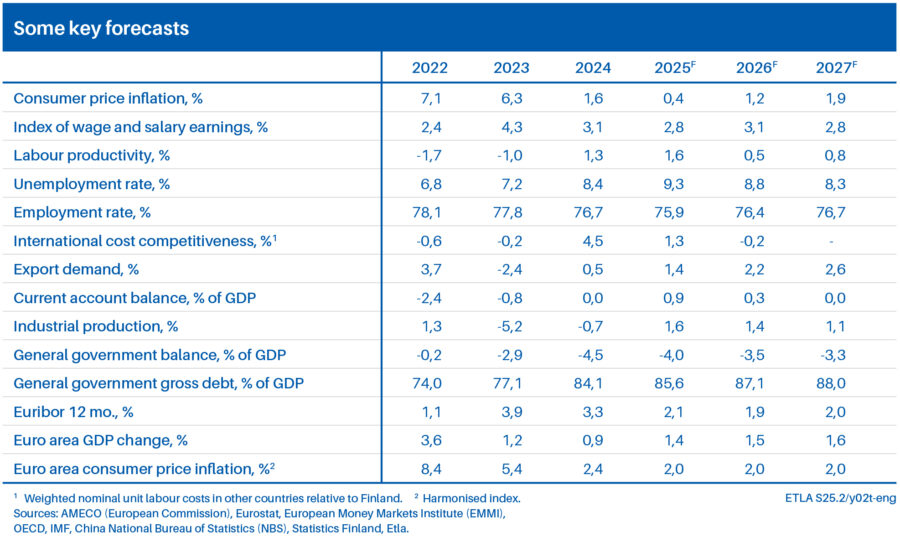
The Finnish economy’s promising growth has unexpectedly halted this year. Consequently, Etla Economic Research has lowered its forecast, predicting growth of only 0.8 per cent for the current year. However, conditions for improvement still exist, with growth of 1.4 per cent forecast for next year. Although the threat of tariffs overshadowing international trade has partly receded, foreign trade alone cannot turn the Finnish economy around. Household consumption has been declining for three consecutive years and has now fallen back to 2018 levels, while the labour market remains sluggish. Nevertheless, Etla’s forecasting group expects a turnaround next year.
In summary, Etla’s forecast is as follows:
The Finnish economy turned from recession to growth at the beginning of last year. A review of the statistics revealed that the economy actually grew by just under half a percent last year. After two weak years, conditions for growth have strengthened further, yet the growth trajectory appears to have stalled this year. Consequently, Etla has lowered its growth forecast for the current year to 0.8 percent. For next year, Etla forecasts growth of 1.4 percent.
However, the conditions for an economic turnaround remain in place. The uncertainty that overshadowed international trade in spring has partly subsided, as the US and the EU have reached an agreement on tariffs. The global economy is expected to grow by 3 percent, with growth in the euro area remaining at around 1.5 percent. Finnish exports will benefit from the upturn in the economies of its trading partners.
Nevertheless, foreign trade will not immediately turn the Finnish economy around, as Etla’s Head of Forecasting, Dr Päivi Puonti, reminds us.
— Export growth will be strong this year, but this is mainly due to one-off factors, such as cruise ship deliveries. In terms of GDP, what matters is net exports, i.e. exports minus imports. Net exports are not a driver of economic growth. Finland’s imports will increase next year as fighter jet deliveries begin and consumption and investment recover.
Investments have already turned to growth, and Etla forecasts that investment will increase by around 2.5 per cent this year and by almost six per cent next year. This development will be driven by the public sector investing in research, development, defence, and infrastructure. Construction is also recovering from its low level but will not reach previous peaks. Purchases of machinery and equipment are growing, and green investments, if realised, could provide a significant boost.

Inflation is forecast to remain close to zero this year as lower interest rates ease borrowing costs. Next year, inflation will accelerate to just over one percent, settling at around two percent in the longer term. Wages are expected to rise by around three percent, and Finland’s cost competitiveness is set to remain strong. Nevertheless, high inflation does not seem to have disappeared from the minds of Finns.
Household consumption is the weakest link this year. Private consumption is declining for the third consecutive year and has already fallen to 2018 levels, despite strengthening purchasing power. Uncertainty surrounding jobs, austerity measures and global crises has made households cautious and reduced their spending. However, according to Päivi Puonti of Etla, we expect a turnaround for the better next year.
The labour market remained sluggish in the early part of the year, with the number of people in employment falling and unemployment rising, particularly in the service sector. Etla forecasts that the unemployment rate will rise to 9.3 per cent this year, before starting to fall again next year.
Growth in public consumption has traditionally supported GDP growth, but the situation is now different. The combined deficit of the state and local government is expected to remain at over €10 billion — more than 4 per cent of the size of the economy — in the coming years. Debt is expected to rise to 88 per cent of GDP by 2027.
— In addition to the multi-year investment programme, the government is increasing defence and R&D investments, and many public expenditure items, such as pensions and interest expenses, are still growing. While increased spending on research and development will strengthen the economic growth in the long term, it will lead to higher spending and debt in the short term, says Päivi Puonti, Head of Forecasting at Etla.
She emphasises that the need for adjustment will therefore remain high for future governments.
With signs of an economic upturn once again delayed, Etla’s CEO, Aki Kangasharju, is calling for bolder action in Finland.
— Economic development fell short of expectations at the beginning of the year, and forecasts need to be revised downwards, as Etla Economic Research is now doing. Anyone following the economy has surely wondered how long we will have to wait for growth to begin, Kangasharju says.
However, he argues that it is increasingly a question of willingness and ability to take risks.
According to Kangasharju, everything seems to be in order in Finland when looking at the factors contributing to growth, yet zero growth continues. In his view, Finland lacks a can-do attitude and a willingness to take risks.
— As there are no other clear obstacles to growth in Finland apart from the ageing population, it is more a question of the desire to grow. The situation now calls for a bolder economic policy. We must dare to take more risks to achieve growth, even if the outcome seems uncertain at first glance.
Among other things, Kangasharju suggests combining a reduction in marginal tax rates with opening education to competition. He also claims that the effects of lowering corporate taxes and increasing immigration are likely to be more positive for Finland than is generally estimated.
— The longer the period of zero growth continues, the bolder we must be in trying out different economic policies to stimulate growth and encourage a growth mindset, Kangasharju concludes.

The online version of Etla’s Economic Forecast “Suhdanne” (in Finnish) is available for reading and downloading at www.etla.fi. All graphs and tables in the online version can also be downloaded separately at www.suhdanne.fi. A PDF version (in Finnish) can be downloaded at www.etla.fi/publications.